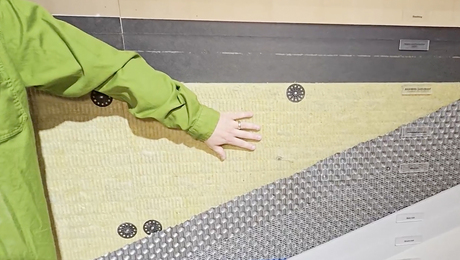Choosing and Installing a Ceiling Fan
The right fan in the right location will keep you comfortable in winter as well as in summer.

Synopsis: A builder explains how to install a ceiling fan in either new construction or an existing ceiling. He includes suggestions on choosing the right size fan, and offers two methods of wiring. The article includes sources of supply.
Here on the Nebraska plains, temperatures can swing from blistering heat to unbearable cold with each passing storm front. As a home builder, I find it difficult to furnish customers with an evenly balanced heating and air-conditioning system. Fortunately, I’ve learned that ceiling fans can do a lot to help maintain comfortable temperatures throughout a house. In warm weather, ceiling fans offer an effective, low-cost alternative to air conditioning. In cold weather, ceiling fans improve air circulation for uniform heat distribution. But any fan in any odd location won’t do. As with most appliances, you’ll have fewer headaches when you buy a quality product, install it correctly, and learn how to use it.
Ceiling fans only make you feel cooler
Our bodies release excess heat by evaporating sweat. Air movement speeds up this cooling process, creating what’s known as wind chill. Wind chill is so effective that breezes stirred by a ceiling fan can make you feel as much as 8°F cooler. Studies have shown that a well-placed ceiling fan can keep most people comfortable (without air conditioning) in temperatures as high as 86°F.
In cold weather, the wind-chill effect discourages the use of a ceiling fan. That’s why manufacturers provide a built-in reverse switch to spin fan blades clockwise, pulling air up gently toward the ceiling. This upward draft helps to mix warm air at ceiling level with colder air near the floor without creating noticeable breeze. In a family room with a 12-ft. cathedral ceiling, for example, temperatures can vary as much as 15°F from floor to ceiling. A properly sized ceiling fan can reduce this stratification to as little as 2°F.
Fans belong where the people are
When locating fans in a home, I pick rooms where people congregate, such as a family room or a master bedroom. For cooling purposes, I look for a house’s hot spots, such as a sunroom or a kitchen breakfast nook. To help balance the air temperatures in the winter, I place fans in rooms with high ceilings and over stairwells. I also place ceiling fans near woodstoves or gas fireplaces because the fans will drive warm air into the rest of the structure, thus warming it more efficiently.
Ceiling height is always a consideration when I’m placing a fan in a house. For safe operation, the fan’s blades must hang at least 7 ft. above the floor and not less than 18 in. from an adjacent wall or sloping ceiling. The optimum height for fan blades is between 8 ft. and 10 ft. above the floor. This fan height promotes the best airflow both summer and winter.
In rooms with high ceilings, I use an extension rod to lower the blades to the proper height. Extension rods for ceiling fans are available in 6-in. increments, up to 8 ft. in length.
For more photos, drawings, and details, click the View PDF button below:
Fine Homebuilding Recommended Products
Fine Homebuilding receives a commission for items purchased through links on this site, including Amazon Associates and other affiliate advertising programs.

Homebody: A Guide to Creating Spaces You Never Want to Leave

Not So Big House

Pretty Good House


























